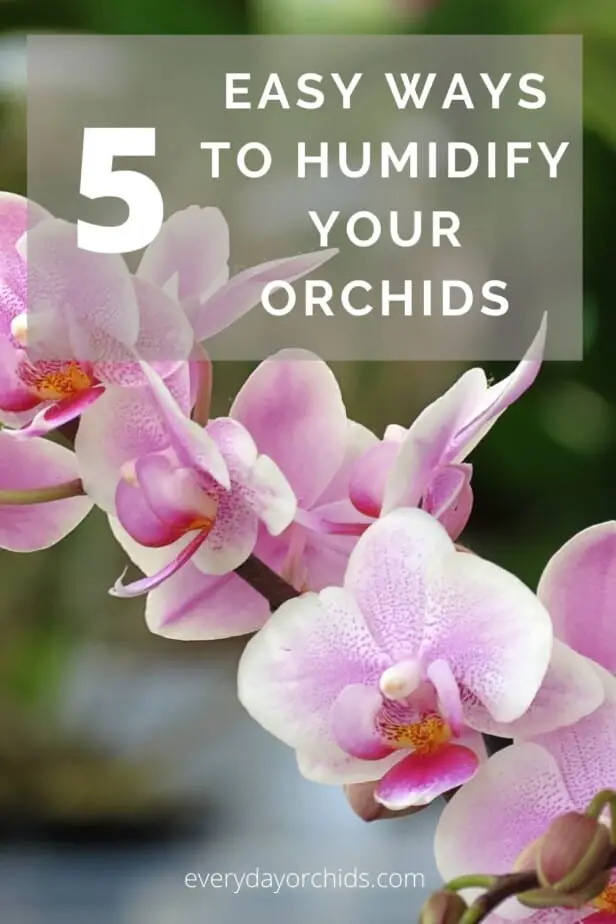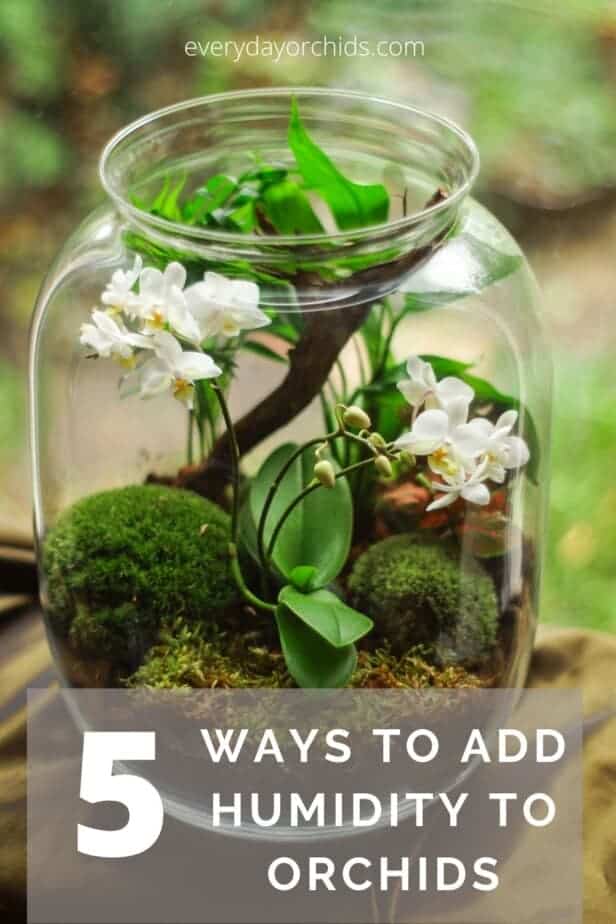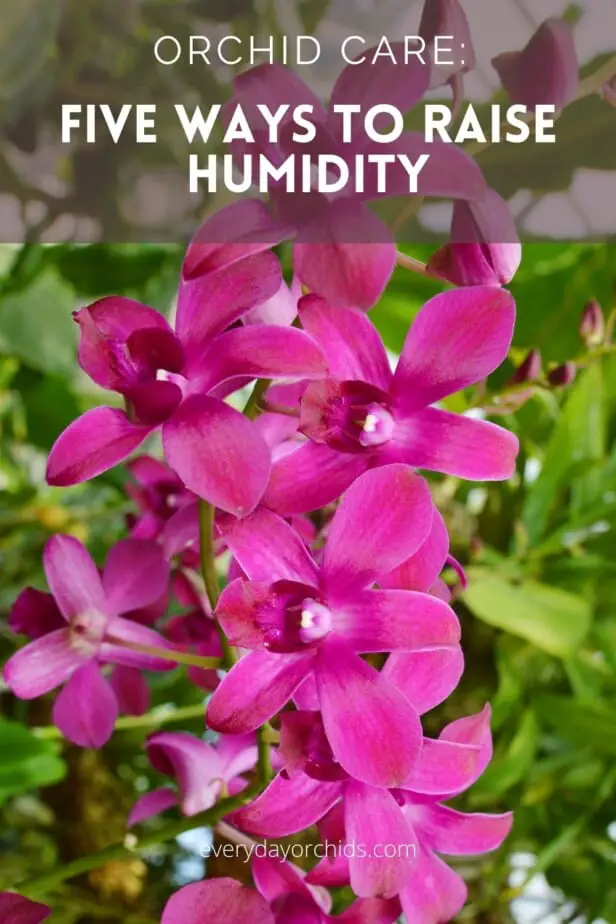If you are looking for ways you can increase humidity around your orchids, you’ve come to the right place. Maintaining the right humidity levels for your orchid is an essential part of orchid care.
You can increase humidity around your orchids by using a cool-mist humidifier, a humidity tray, humidity box, or a humidity dome. For a classy, decorative look, use a terrarium or mini-greenhouse to maintain humidity levels around your orchid. Aim for a humidity level between 40-70%, as this range works for most orchids.
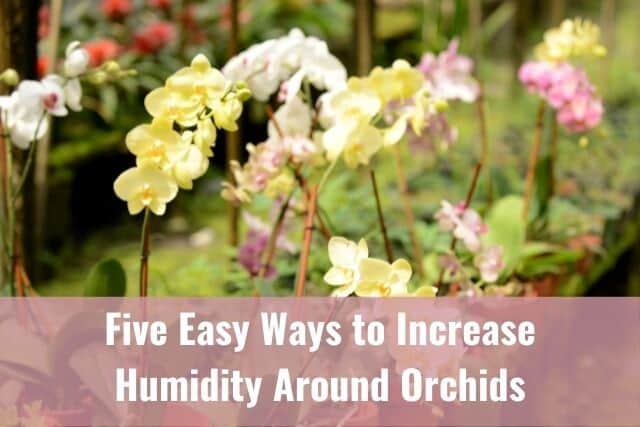
Many of these methods are simple and easy to set-up. I’ll go over each one below in more detail. You’ll get some recommendations to get you started. Keep reading to learn more about some easy ways you can increase humidity for your orchids.
Please note that these links are affiliate links and as an Amazon Associate, I earn from qualifying purchases. Purchases made through affiliate links in this post may generate commissions at no additional cost to you. Use this link for a discounted Amazon Prime trial. Thank you for your support!
Table of Contents
How Do I Keep My Orchids Humid?
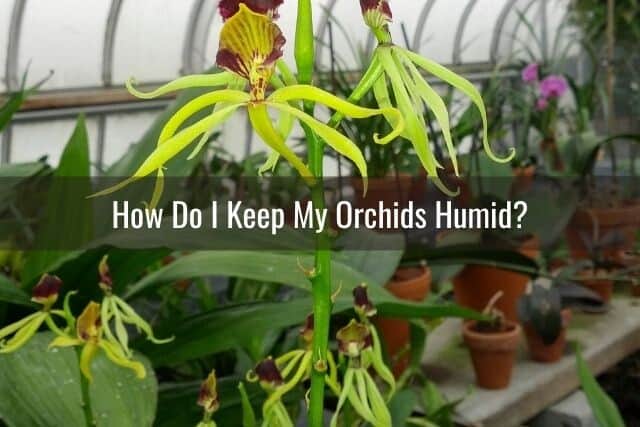
Humidity levels indoors can range from 30-50%. During the fall and winter, humidity levels can be even lower. This is in part because many people use central heating to warm their homes.
As a result, humidity levels can fall below what is ideal for orchids and slow down growth. If you’d like to learn more, read about why humidity is so important for your orchid here.
If you aren’t sure what humidity levels are around your orchid’s growing area, you can easily find out using a hygrometer.
Hygrometers are humidity sensing devices. They are relatively inexpensive and a must-have for any orchid grower. Many hygrometers will display temperature readings in addition to humidity readings.
Most orchids need a humidity level between 40-70% in order to grow and bloom properly. Since indoor humidity levels are usually lower than what is ideal for an orchid, orchid growers will need to take some steps to add humidity to their orchid’s growing area.
There are a few ways to increase humidity for your orchids. You can increase humidity in the room, using a cool-mist humidifier. Or you can raise humidity directly around your orchids, using a humidity tent, box, or tray. I will talk about each these methods below. Check out each one so you can determine which method is best for you and your orchids.
Please note: The next three methods do their best to create greenhouse-like conditions for your orchid.
Use a Terrarium or a Greenhouse for Your Orchids
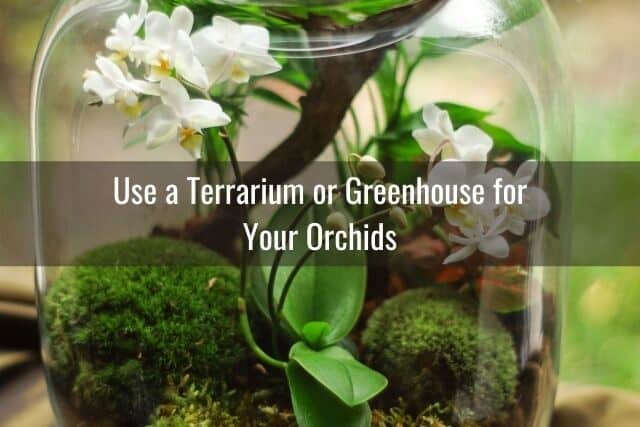
Terrariums and greenhouses can come in a variety of shapes and sizes. The majority of quality terrariums have glass “windows” or panes along the sides and allow for ample light exposure. In addition, most terrariums and greenhouses have open windows or vents along the top to allow for air circulation and heat to escape. The enclosed space keeps the growing area humid for your orchid and other plants.
Greenhouses and terrariums can range in price, based on quality, design and size. However, a well-constructed terrarium or greenhouse can last you for many years.
Terrariums for Orchids
There are tabletop-sized terrariums available, including ones shaped like miniature greenhouses or have geometric shapes. This is probably the loveliest option for your orchids. If you can get your hands on a glass terrarium that can fit your orchids, go with this method.
If you are just starting out, you can also purchase a terrarium kit. This comes with moss, rocks and charcoal to line and decorate the base of the terrarium around your orchid.
In addition to providing a living space and high humidity for your orchid, terrariums are beautiful enough to be used as centerpieces or as part of the home’s decor.
Greenhouses for Orchids
There are a variety of greenhouses sizes available, with the larger outdoor versions priced upwards into the thousands. Fortunately, indoor greenhouses are smaller, and therefore, much less expensive.
If you have a spare room, sun room, or any extra space in your home that gets good lighting, you might want to invest in a mini greenhouse. This would be perfect for orchids or seed starting.
For example, this mini greenhouse by KitchenJoy is designed for indoor use. It has adjustable/removable shelving and adjustable roof panels to let air circulate in. There’s enough space for multiple orchids on each row. You can even add grow light strips underneath each shelf to add artificial lighting to the orchids on the lower levels.
Whatever you choose, just be sure to get something well-constructed. That way, you’ll be able to house your orchids in it for multiple seasons.
Make a Humidity Dome for Your Orchids
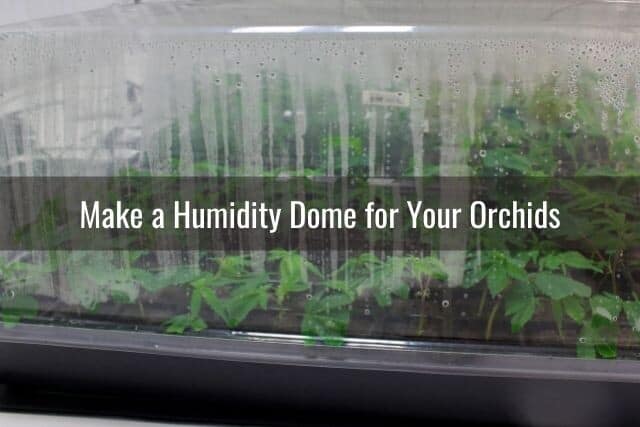
Humidity domes work to trap evaporating moisture around the orchid. The enclosed nature of the dome creates a humid micro-environment for your orchid.
A humidity dome may not look as fancy as a terrarium or a greenhouse, but it will provide greenhouse-like conditions for your orchid and increase humidity around your plant.
Keep in mind that temperatures inside the dome may heat up quickly. I suggest using a dome that has vents at the top to allow you to regulate the heat and humidity within the dome.
Bell Covers as a Humidity Dome
Clear bell-shaped covers work well as humidity domes to go over your orchid. These Reusable Plastic Bell Cover for Plants are 8 inches in diameter by 7 inches tall. There is an adjustable vent at the top of the dome. This will allow you to manage humidity, temperature and airflow for your orchid without needing to remove the dome.
These bell covers would work well for mini orchids or smaller orchids. When placing your orchid underneath the dome, make sure the leaves do not touch the sides. If the leaves are in constant contact with the condensation on the insides of the dome, this could lead to brown spot and mold growth.
For orchids with bigger leaves but without flower spikes, you can use a plastic greenhouse lid such as this mini greenhouse. There are two vents on top which allow you to adjust the humidity and temperature. Depending on the span of your orchid’s leaves, you can fit one or two into this space.
Use a Humidity Box For Your Orchids
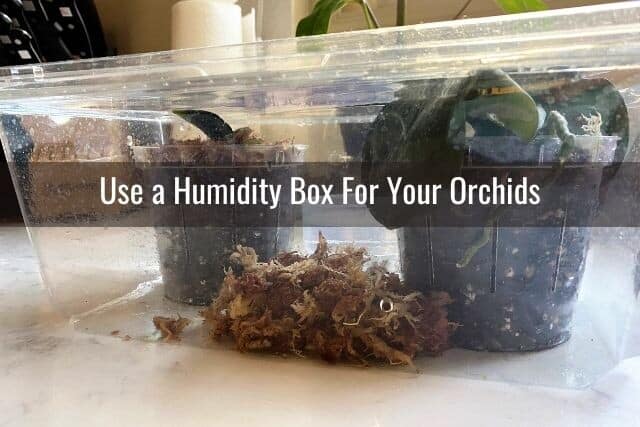
Humidity boxes are very similar to humidity domes and terrariums, in that they mimic a mini-greenhouse environment for the orchids. I have gone into more detail about humidity boxes in another post, including how to make a humidity box and how to use humidity boxes to quickly grow orchid roots. Please check out that article for more information.
I have used humidity boxes for orchids (Phalaenopsis variety) that I wanted to try and save. I found the method simple, easy to execute and very effective. In just a month, my two Phalaenopsis orchids in the humidity box were able to grow new leaves and multiple new root buds.
I did leave the humidity box open a crack for air circulation and rehydrated the sphagnum moss every few days. I watered my orchids as usual and was impressed by the growth they showed in the humidity box. If you are looking to save an orchid without roots or grow orchid roots quickly, this may be a good option.
Make a Humidity Tray For Your Orchids
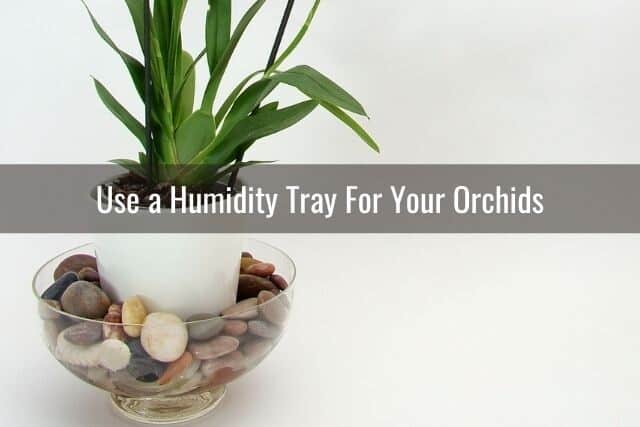
Humidity trays are commonly used under orchids and other plants to passively raise humidity around the plant. These are easy to prepare and DIY. All you really need is a shallow tray, some rocks and water. You can use river rocks to line the tray, multi-color glass stones or pebbles, or even (cleaned) rocks from your garden.
Once you have your supplies, line the bottom of the tray with rocks or stones. Fill the tray partway up with some water. Place your orchid pots on top of the rocks. Make sure that the bottom of the pots don’t actually come into contact with the water.
As the water evaporates, it will provide some humidity to the orchids. An added benefit of these humidity trays is that you can set your orchid pots on these rocks after watering. You can let the water drain from the pots into the tray below and not worry about emptying the tray afterwards.
Potential Issues with Humidity Trays
One thing to keep in mind is that standing water, even in a humidity tray, can provide a breeding ground for bacteria and insects, such as mosquitoes.
To prevent bacterial, mold, algae, or insect growth, regularly change out the standing water from the trays. When you do so, clean the trays and the rocks as well.
If you prefer, you can put bits of mosquito dunk in the water of the humidity tray to keep away insects. Mosquito dunks contain BTI, a form of biological control. It prevents insects such as fungus gnats and mosquitos from being attracted to the standing water.
If you have pets or small children in the house, using mosquito dunks in the humidity tray is not recommended. There is the risk that they may accidentally ingest the mosquito dunk bits. These are poisonous if ingested.
Use a Cool-Mist Humidifier For Your Orchids
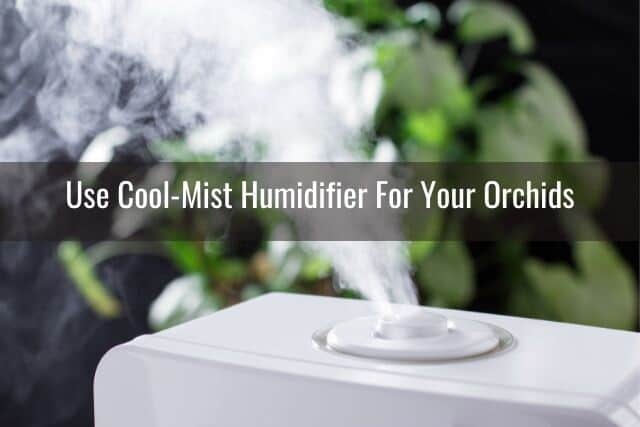
Cool-mist humidifiers are great ways to increase indoor humidity for orchids. There are many models available out on the market, allowing you to choose the style and size that best fits your needs. This is a great option if your goal is to increase humidity in a room or if you have a larger number of orchids that need humidification.
Most humidifiers have a dial to adjust the amount of humidification being produced. Start on the lowest setting. Based on your hygrometer’s readings and your orchid’s preferred humidity level, you can adjust the humidifier higher as needed.
I would recommend using a cool-mist humidifier over a warm-mist humidifier. This is mainly for safety reasons.
If a warm-mist humidifier accidentally gets knocked over or spills, the heating element or hot water can cause burns and damage. If you are living in a household with pets or small children, cool-mist humidifiers will be a better, safer option.
The main thing to watch out for with these humidifiers is bacterial and mold growth. If the humidifier is not maintained regularly, bacteria and mold can grow and accumulate rapidly. To prevent this from happening, be sure to clean your humidifier daily and dump out any standing water.
Mini Cool-Mist Humidifiers
Here are some suggestions for mini cool-mist humidifiers. This size is ideal if you have just one or two orchids or are looking to increase humidity in a smaller space:
- This portable mini humidifier holds 500ml of water and can run continuously for 12 hours at a time. It is small enough to sit on a desktop or tucked away near your orchids. It has a quiet run setting and comes highly rated and reviewed.
- This mini cool-mist humidifier by Vicks has a half gallon capacity and can run continuously for 20 hours. Like the other humidifier, it has a quiet setting and will automatically turn off when it runs out of water. The tank’s wide opening allows for easier cleaning as well.
- This sleek mini humidifier by Jisulife has a built-in battery. This will run for 5-10 hours after being fully charged (depending on if you turn on one or two nozzles). Cleaning is super easy–just remove the cover and wipe down the empty water tank with a soft cloth. Its compact design allows it to fit in unobtrusively among your orchids.
Standard-Sized Cool-Mist Humidifiers
For larger orchid collections, I would recommend getting a standard-sized cool-mist humidifier. These humidifiers have a larger tank capacity and can run for a longer period of time between refills.
- I use this Crane Drop ultrasonic cool-mist humidifier in our home. You can adjust the settings using the dial. This humidifier can cover up to a 500 square foot room, perfect if you have a lot of plants or orchids. The one gallon tank size can last for up to 24 hours and is fairly easy to clean.
- Our family also uses something similar to this AquaOasis humidifier. (Yes, we have more than one humidifier.) This one also has a large tank capacity, about 2.2 L, and can run continuously over 24 hours on one full tank. It has a rotating, adjustable nozzle, which allows you to aim the humidification towards your plants. This size humidifier can also cover a large room.
Misting Orchids–Is This Worth Your Time?

Misting orchids provides some temporary moisture to orchids, but it doesn’t raise ambient humidity levels enough to be worth your time, in my opinion. The small amount of water produced by a mister quickly evaporates. The amount of humidity created by misting your orchids every so now and then is really negligible.
In fact, misting the orchid roots and surface of the potting media on a regular basis can actually do more harm than good. I used to mist my orchids, but stopped for the following reasons.
Potting Media Decomposition
For one thing, misting the roots and top of the orchid bark keeps the potting media moist, which can lead to faster decomposition and break down of the potting media. You will need to repot the orchid sooner as a result. As potting media breaks down into smaller pieces over time, there is also an increased risk for root rot due to less air circulation around the orchid roots.
Fungus Gnats and Bacterial Problems
Based on my experience, misting can also encourage the growth of fungus gnats. These pesky flying insects require moist, decaying media in order to lay their eggs and populate. Misting helps maintain this environment for them. I noticed that once I stopped regularly misting my orchids, the amount of fungus gnats around my orchids decreased considerably.
When misting, you also need to be careful not to get the leaves or orchid blooms wet. Contaminated water left on orchid leaves can lead to brown rot and brown spot, two bacterial diseases that spread quickly in orchids.
Orchid blooms that are constantly wet due to improper watering or high humidity are susceptible to Botrytis. This is a fungal disease that causes petal blight.
You can read more about the pros and cons of misting your orchids here. Note that simply misting your orchids is different than feeding your orchids with a fertilizer mist spray. Some people choose to feed their orchids using a mist spray and this is a perfectly acceptable way to fertilize orchids.
In my opinion, if you want to increase indoor humidity for your orchids, invest in a hygrometer and a humidifier. Or use a humidity tray, humidity box, or dome, as outlined above. Any of these other methods would be more effective in providing humidity for your orchid plants.
Final Thoughts
If you find out that your home’s humidity levels are lower than what is preferred by your orchids, don’t stress. As outlined above, you have a lot of options for raising humidity levels around your orchids.
Some methods are more expensive than others, and some may be more aesthetically pleasing than other options. Choose the one that works best for you and your orchids. I personally use a mix of the above methods, based on what different orchids need.
In addition, there likely many other ways to raise humidity for your orchids that I haven’t mentioned here. This is just a guide to get you started in the right direction.
As always, happy orchid growing!
If you enjoyed this article, please pin it and share!
